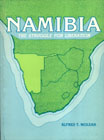Facts on the Ground
Review of Namibia, The Struggle for Liberation by Alfred T. Moleah. Disa Press. 341 pages.

For a territory hovering on the brink of nationhood, the dispute over which has become practically a full-time occupation for many government officials in South Africa, Europe, the USA and the United Nations, not much has been written about Namibia. What exists are mostly political manifestos or specialized studies: examinations of Namibia's mines, fisheries, governmental systems, and military-strategic importance.
Namibia, The Struggle for Liberation is something else. The work of an exiled South African, now a professor of political science at Temple University, it is basically a political history of the territory -- but with a difference. Readers used to the dry "objectivity" of standard history texts may be startled when the author uses words like "nefarious" and "dastardly" or comments that the US policy on Namibia "would be hilarious if it were not so tragic." It is a risky way to approach the subject, but in this case probably essential. Is it really possible or desirable to write dispassionately about the South African attack on the Kassinga refugee camp? Or about the role of Henry Kissinger in pressuring Gulf Oil to support UNITA in the Angolan civil war?
Professor Moleah's rhetoric may prevent his book from becoming, as it should, a basic text for college courses on Southern Africa, but it has important benefits, too. Namibia is above all an interpretive history. Moleah deals with events as recent as March 10, 1983 -- a remarkable feat for a 1983 book -- but what is more remarkable than that is that he deals with them thoughtfully. He does not slide from repeating the opinions of other historians to repeating the opinions of journalists, as so many authors do when they approach the present time. For instance, rather than simply condemning South Africa for its constant demands that Cuban troops must leave Angola before Namibia can be free, Moleah points out that the demand itself is a ruse. South Africa does not really want the Cubans to go home. They are too useful as straw men to block independence. So long as South Africa continues to occupy southern Angola and to maintain its reign of terror, the Angolan government cannot afford to let the Cubans go; and as long as the Cubans stay in Angola the South Africans have an excuse for their intransigence.
A continuing theme of this book is the disparity between reality as it is seen in the halls of government buildings in Windhoek, Pretoria, and the UN, and what the author refers to as "facts on the ground." The most basic of these facts is the existence of apartheid in a territory South Africa has repeatedly pledged itself to protect and develop. Ever since South West Africa -- formerly a German colony -- was first turned over to South Africa as a Class C Mandate after World War I, the South Africans have seen their role there as nothing less than outright annexation. Namibia came to be treated as an underdeveloped fifth province, an extension of South Africa itself.
Bantustans, the linchpin of the apartheid system in its home country,were established in Namibia in 1968. The other familiar features of apartheid have accompanied this: segregated neighborhoods, puppet bantustan governments, contract labor, and forced removals of the African population, often at gunpoint. Aggravating these enormous burdens have been the added hardships imposed by the creation of a free-fire zone in the north and by the lawlessness inherent in a garrison state. In addition to South African regulars -- one for every six Namibian adults -- the land is beset with private corporate armies, mercenary and vigilante forces, secret units and commando teams. Even the SADF troops, it appears, have a policy of not taking prisoners. How much worse, then, must be operations carried out by the "white psychopaths and sociopaths" of the Police Special Task Force or by the elite black troops of Koevoet, a force "notorious for its brutality and ruthlessness."
The author, however, sees some light through the chinks in the armor plate. SWAPO, too, has been creating facts on the ground. Cooperating with trade unions in 1971-72, SWAPO helped engineer the country's largest and most effective strike action. Despite the brutal opposition of the continent's most powerful military machine, SWAPO troops have begun to penetrate the previously sacrosanct white farming areas of Namibia. And following the abject failure of South Africa's own "hearts and minds" campaign of 1976 it became obvious even to South Africa and its supporters that SWAPO would win a free and fair election by an overwhelming margin. In explaining why this is so, Moleah uses another phrase which, like "hearts and minds," is reminiscent of Vietnam and the 1960s. "As Africans are wont to say" -- the author points out -- "nobody can stop the rain."
Published in IDAF News Notes, December 1983.


